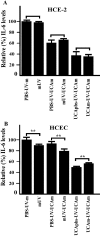Cis-urocanic acid suppresses UV-B-induced interleukin-6 and -8 secretion and cytotoxicity in human corneal and conjunctival epithelial cells in vitro
- PMID: 19753313
- PMCID: PMC2742640
Cis-urocanic acid suppresses UV-B-induced interleukin-6 and -8 secretion and cytotoxicity in human corneal and conjunctival epithelial cells in vitro
Abstract
Purpose: Urocanic acid (UCA) is a major ultraviolet (UV)-absorbing endogenous chromophore in the epidermis and is also an efficacious immunosuppressant. The anti-inflammatory and cytoprotective effects of cis-UCA were studied in ocular surface cell cultures exposed to UV-B irradiation.
Methods: Human corneal epithelial cells (HCE-2) and human conjunctival epithelial cells (HCECs) were incubated with 10, 100, 1,000, and 5,000 microg/ml cis-UCA with and without a single UV-B irradiation dose. The concentrations of IL-1beta, IL-6, IL-8, and TNF-alpha in the culture medium and caspase-3 activity in the cell extract sampled were measured by enzyme-linked immunosorbent assay (ELISA). Cell viability was measured by the colorimetric MTT (3-(4,5-dimethyldiazol- 2-yl)-2,5-diphenyltetrazolium bromide) assay.
Results: UV-B irradiation multiplied interleukin IL-6 and IL-8 secretion levels in HCE-2 cells and HCECs as analyzed with ELISA. Cell viability as measured by the MTT assay declined by 30%-50% in HCE-2 cells and by 20%-40% in HCECs after UV-B irradiation. Moreover, UV-B increased caspase-3 activity in both cell types as analyzed with ELISA. Treatment with 100 microg/ml cis-UCA completely suppressed IL-6 and IL-8 secretion, decreased caspase-3 activity, and improved cell viability against UV-B irradiation. No significant effects on IL-6 or IL-8 secretion, caspase-3 activity, or viability of the non-irradiated cells were observed with 100 microg/ml cis-UCA in both cell types. The 5,000 microg/ml concentration was toxic.
Conclusions: These findings indicate that cis-UCA may represent a promising anti-inflammatory and cytoprotective treatment option to suppress UV-B-induced inflammation and cellular damage in human corneal and conjunctival epithelial cells.
Figures







Similar articles
-
Cis-urocanic acid inhibits SAPK/JNK signaling pathway in UV-B exposed human corneal epithelial cells in vitro.Mol Vis. 2011;17:2311-7. Epub 2011 Aug 27. Mol Vis. 2011. PMID: 21921982 Free PMC article.
-
UV-B-Induced Inflammasome Activation Can Be Prevented by Cis-Urocanic Acid in Human Corneal Epithelial Cells.Invest Ophthalmol Vis Sci. 2020 Apr 9;61(4):7. doi: 10.1167/iovs.61.4.7. Invest Ophthalmol Vis Sci. 2020. PMID: 32271889 Free PMC article.
-
Constitutive and UV-B modulated transcription of Nod-like receptors and their functional partners in human corneal epithelial cells.Mol Vis. 2008 Aug 29;14:1575-83. Mol Vis. 2008. PMID: 18769647 Free PMC article.
-
Studies to determine the immunomodulating effects of cis-urocanic acid.Methods. 2002 Sep;28(1):63-70. doi: 10.1016/s1046-2023(02)00210-4. Methods. 2002. PMID: 12231189 Review.
-
Mast cells in UV-B-induced immunosuppression.J Photochem Photobiol B. 2000 Apr-May;55(2-3):81-7. doi: 10.1016/s1011-1344(00)00032-4. J Photochem Photobiol B. 2000. PMID: 10942071 Review.
Cited by
-
Trans-urocanic acid enhances tenofovir alafenamide stability for long-acting HIV applications.Int J Pharm. 2020 Sep 25;587:119623. doi: 10.1016/j.ijpharm.2020.119623. Epub 2020 Jul 11. Int J Pharm. 2020. PMID: 32663582 Free PMC article.
-
Cis-urocanic acid inhibits SAPK/JNK signaling pathway in UV-B exposed human corneal epithelial cells in vitro.Mol Vis. 2011;17:2311-7. Epub 2011 Aug 27. Mol Vis. 2011. PMID: 21921982 Free PMC article.
-
Topical cis-urocanic acid prevents ocular surface irritation in both IgE -independent and -mediated rat model.Graefes Arch Clin Exp Ophthalmol. 2017 Dec;255(12):2357-2362. doi: 10.1007/s00417-017-3781-z. Epub 2017 Aug 24. Graefes Arch Clin Exp Ophthalmol. 2017. PMID: 28840310
-
cis-Urocanic acid attenuates acute dextran sodium sulphate-induced intestinal inflammation.PLoS One. 2010 Oct 27;5(10):e13676. doi: 10.1371/journal.pone.0013676. PLoS One. 2010. PMID: 21060867 Free PMC article.
-
Beneficial health effects of ultraviolet radiation: expert review and conference report.Photochem Photobiol Sci. 2025 Jun;24(6):867-893. doi: 10.1007/s43630-025-00743-6. Epub 2025 Jun 4. Photochem Photobiol Sci. 2025. PMID: 40465176 Review.
References
-
- Gibbs NK, Tye J, Norval M. Recent advances in urocanic acid photochemistry, photobiology and photoimmunology. Photochem Photobiol Sci. 2008;7:655–7. - PubMed
-
- Prater MR, Blaylock BL, Holladay SD. Molecular mechanisms of cis-urocanic acid and permethrin-induced alterations in cutaneous immunity. Photodermatol Photoimmunol Photomed. 2003;19:287–94. - PubMed
-
- Lauerma AI, Aioi A, Maibach HI. Topical cis-urocanic acid suppresses both induction and elicitation of contact hypersensitivity in BALB/C mice. Acta Derm Venereol. 1995;75:272–5. - PubMed
-
- Hart PH, Grimbaldeston MA, Finlay-Jones JJ. Mast cells in UV-B induced immunosuppression. J Photochem Photobiol B. 2000;55:81–7. - PubMed
-
- el-Ghorr AA, Norval M. The effect of chronic treatment of mice with urocanic acid isomers. Photochem Photobiol. 1997;65:866–72. - PubMed
Publication types
MeSH terms
Substances
LinkOut - more resources
Full Text Sources
Research Materials
